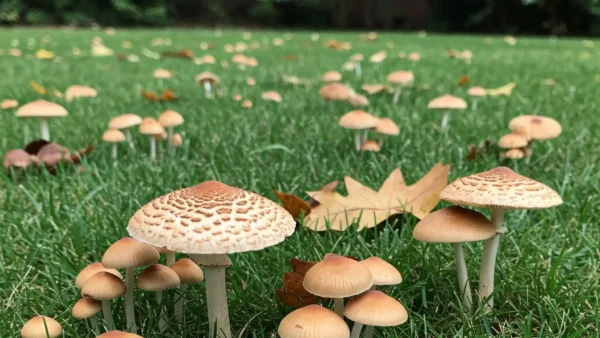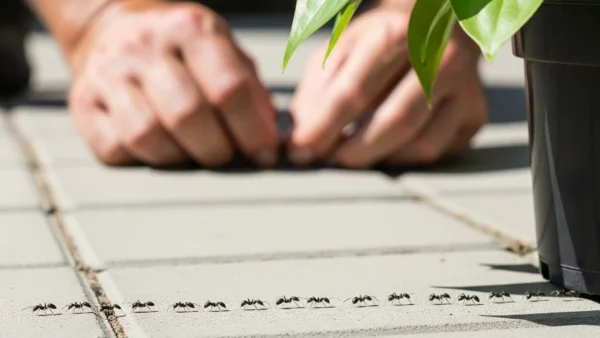The Gardener’s Secret Weapon: How to Make Garlic Spray for Plants
Weeks of tending to your tomato plants have seen them develop from small seedlings into strong, fruit-bearing vines. Every day you check on them; one morning you discover that a cluster of small, green aphids has invaded the most recent, most vulnerable leaves, therefore transforming your future crop into their personal feast. Alternatively you might have found thin, almost invisible webbing on your beloved roses, the tell-tale clue of a spider mite invasion. Your heart feels as though it falls. What if I told you the most effective weapon in your pest-control tool is probably already sitting in your kitchen before you grovel yourself to a visit to the garden center to peruse the aisles of strong chemical sprays?
Any organic gardener will find it revolutionary to learn how to create garlic spray for plants. It’s a rite of passage—a trick handed down through the years that seems like a well-kept secret. Safe for your family, your pets, and the environment, this basic, homemade mixture uses the strong natural qualities of garlic to create a spray that repels and disturbs a broad spectrum of typical plant pests.
This book will not only provide a detailed recipe but also explore the intriguing science behind why it works so remarkably. We’ll go over the pests it targets, how to apply it for best impact without damaging your plants, and the typical mistakes to prevent. Prepare to take back your garden with the tools you already own.
Why Do Pests Hate Garlic? The Science Behind the Scent
Understanding why a homemade cure is more than just a folk story allows one to really trust it. The secret of garlic spray is not just its quite strong scent but also the potent, volatile sulfur chemicals present in every clove. This is where small kitchen chemistry finds use.
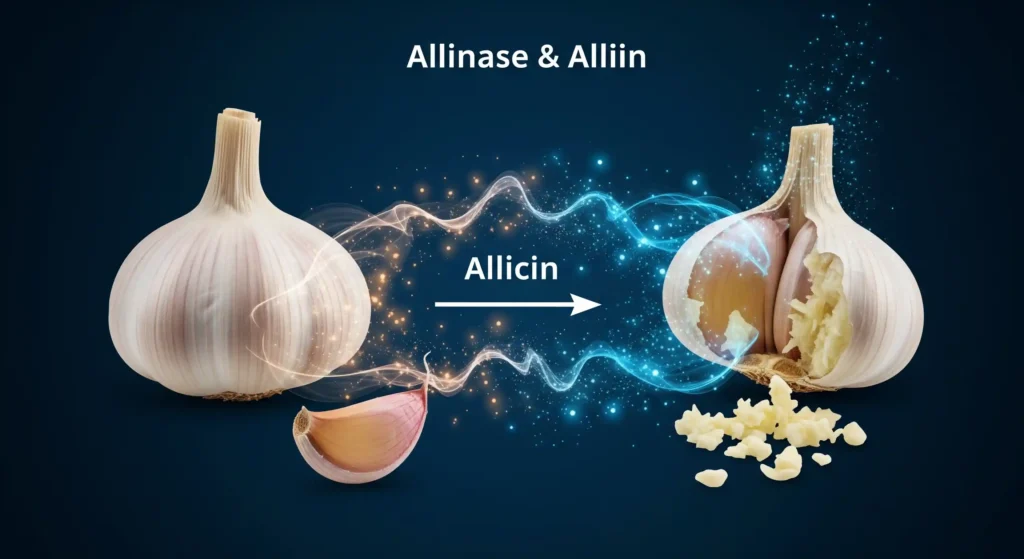
Held in different cellular compartments, a garlic clove in its entire, undisturbed state comprises an enzyme called alliinase and a molecule called alliin. But the two mingle when you crush, cut, or blend the clove, so rupturing those cell walls. This sets off a quick chemical reaction whereby alliinase turns alliin into a fresh, quite strong molecule: allicin. This is the exact same chemical causing the unique smell of garlic and its well-documented health advantages; it is also what makes it a strong pest control agent on several angles.
- As a Repellent: For many insects, the strong, pungent smell of allicin is intolerable to their delicate olfactory receptors. Aphids and beetles discover their food by focusing on the particular chemical signals their chosen plants generate. Garlic spray masks the wonderful aroma of your roses or kale, therefore functioning as a cloaking agent. It’s like a strong “no vacancy” sign confusing pests and pushing them into a less potent site.
- As an Antifeedant & Irritant: The experience is far from pleasant for the bugs that are relentless enough to settle on a treated plant. The sulfur compounds taste horrible and irritate them greatly. This deters them from eating and usually helps them to give up the plant in quest of a more appetable meal.
- As a Mild Contact Insecticide: Garlic spray does directly affect some bugs even if it is mostly a repellent. Garlic’s components can dissolve the protective outer covering (their cuticle) of soft-bodied insects including aphids, spider mites, and whiteflies, therefore inducing dehydration. Although it’s a far milder activity than a manufactured chemical, with regular application it can be really powerful.
Your Arsenal of Garlic: Three Powerful Recipes
Knowing the “why,” let’s now address the “how.” These three simple formulations range from a basic all-purpose spray to more potent forms for tough bugs.
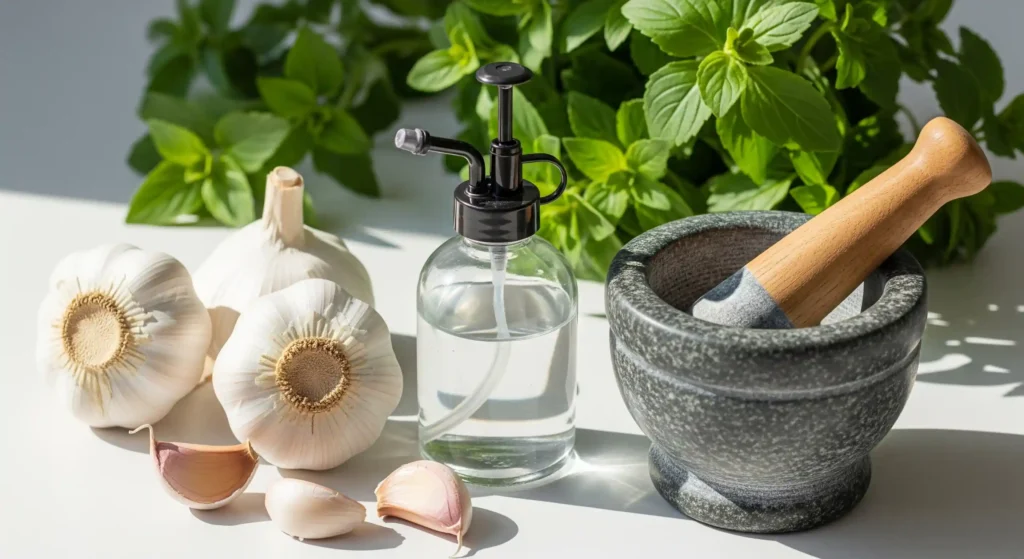
Recipe 1: Basic All-Purpose Garlic Spray
This is your basic dish. Perfect for general-purpose use and preventative maintenance, it is straightforward, powerful.
- Ingredients: Two complete heads of garlic, four cups of water, a spray bottle.
- Directions:
- Sort all the cloves from the two garlic heads first. Peel them not at all necessary!
- Either finely minced or better still, place the cloves—roughly chopped—into a blender or food processor with a splash of water and pulse until they are. You make more allicin the more cell walls you shatter.
- Put the minced garlic in a jar or bowl with the four cups of water. Swish it well.
- Cover the container and let it steep room temperature at least 12 hours, or overnight. This lets the allicin totally dissolve into the water.
- Strain the mixture through a double layer of cheesecloth, a fine-mesh sieve, or even an old—but clean!—t-shirt. To prevent clogging your spray container, you have to eliminate every microscopic garlic particle. On this one, trust me.
- Your spray container should be filled with the strained liquid; it is ready for use.
- Pro-Tip: Try switching one of the heads of garlic with one big yellow onion for an even more powerful and sophisticated repellant. When coupled with garlic, onions’ own sulfur components produce an even more perplexing aroma profile for bugs.
Recipe 2: The “Sticker” Spray (with Oil and Soap)
My go-to is this improved version personally. A surfactant, a tiny bit of mild soap helps the spray stick better to plant leaves and break the surface tension of the water. Additionally helping to suffocate soft-bodied insects like aphids and mites is the oil.
- Ingredients: One batch of the Basic All-Purpose Garlic Spray; one teaspoon of mild liquid soap (unscented castile soap is ideal; avoid degreasing dish detergues); one tablespoon of vegetable oil.
- Directions:
- As directed above, prepare the basic garlic water and strain it very gently.
- Put the garlic water in your spray bottle just before you’re ready to blast.
- Add vegetable oil and the liquid soap.
- To emulsify the water and oil, shake the bottle briskly. To keep it combined, you will have to shake it sometimes while use.
Recipe 3: Extra Spicy Repellent for Stubborn Pests & Mammals
Adding hot pepper is the best approach when you have to draw out the big guns for a severe infestation or stop more major pests like squirrels and rabbits from burrowing in your pots. The strong irritant capsaicin in the peppers is one which animals especially cannot tolerate.
- Ingredients: Three to four fresh spicy peppers—such as habaneros or jalapeños—plus one tablespoon of cayenne pepper powder OR Basic Spray’s components. Handle hot peppers always with gloves!
- Directions:
- If using fresh peppers, roughly chop them (gloves on!).
- Before steaming, toss the minced garlic and water combination with the chopped peppers or cayenne powder.
- Let the whole mix steep over night. Along with the allicin, the capsaicin will dissolve into the water.
- Strain with great care. Given the strong fumes, you could wish to conduct this in a well-ventilated space.
Application Guide: Using Your DIY Garlic Pesticide
Achieving the greatest results and maintaining the health and happiness of your plants depend on proper application of your strong potion blended and ready.
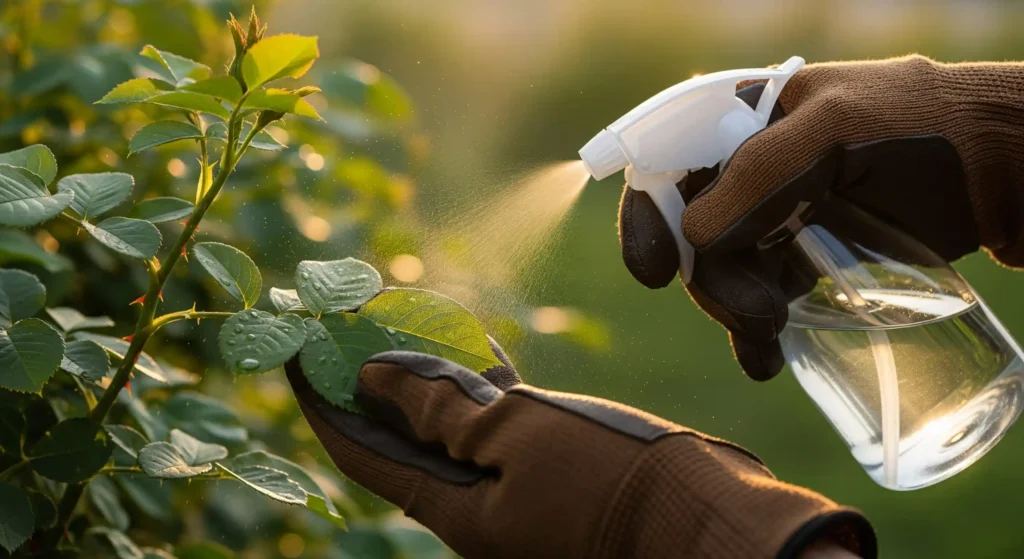
- Always Test First: Any homemade spray’s cardinal rule is this. Spray a tiny, inconspicuous leaf before you destroy your whole prize-winning rose shrub or row of tomatoes and wait 24 to 48 hours. Look for any burning, yellowing, or spots. This guarantees that, particularly the formulations with oil or pepper, your particular plant is not sensitive to the spray.
- Select the Correct Hour of Day: Time is everything. Spray at late evening or very early in the morning. Any spray applied in the heat of noon sun while the stomata of the plant are wide open will burn the leaves, a phenomenon known as phytotoxicity. If used at the incorrect moment, the oil in Recipe #2 especially can function as a sun’s beam magnifying glass.
- Be Thorough: Pests are crafty. They enjoy hiding deep within the plant’s canopy, in the cracks where fresh growth arises, and on the undersides of leaves. Not very much will a short spritz on top of the foliage accomplish. You should be comprehensive. Spray the whole plant until it is pouring; the tops and most crucially the bottoms of all the leaves, the main stalks, and the base of the plant where slugs could hide.
- Reapply Consistently: There is no “one and done” chemical answer here. Natural, biodegradable product is homemade garlic spray. It washes away totally in the rain and breaks down in sunlight. Consistency is what determines its success. Under an active infestation, you should schedule to reapply your spray every three to five days until the pest pressure noticeably drops. One great habit to get into for preventative maintenance during peak bug season is a weekly spray.
Who Opposes Garlic? (Pests vs. Plants)
Although garlic spray is a great weapon, it’s crucial to know exactly which garden enemies it targets and which allies to guard.
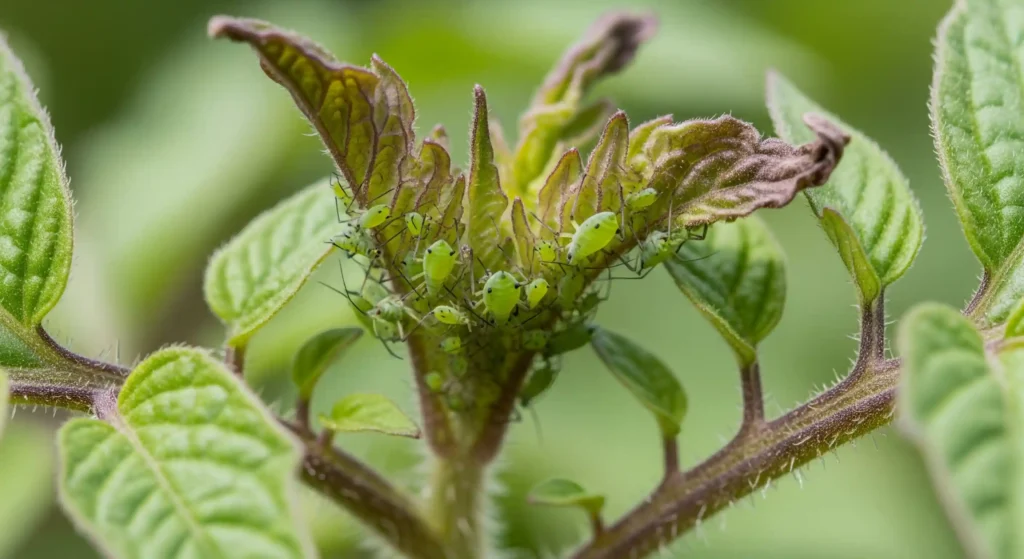
Pests It’s Most Effective Against
- Soft-bodied sucking insects: Garlic spray really comes through in soft-bodied sucking insects. Against whiteflies, spider mites, and aphids it’s great.
- Beetles: It serves more as a repellant against hard-bodied beetles such as Japanese beetles and flea beetles, therefore deterring them from landing and feeding.
- Slugs & Snails: They will often avoid crossing a barrier of garlic and really hate it.
- Mammals: The “Extra Spicy” variety can be quite successful in discouraging deer, squirrels, and even rabbits from sampling your crops.
A Note on Beneficial Insects
Especially when used properly, one of the best things about garlic spray is its relative safety for pollinators like bees and helpful predators like ladybugs. Whereas broad-spectrum chemical pesticides kill indiscriminately, garlic spray is essentially a repellant. Generally speaking, bees are not active late in the evening when spraying is most ideal. Usually avoiding the treated regions regardless, they negotiate by scent. Though it is mostly a repellant, a direct, heavy spray can nonetheless damage or irritate delicate beneficials like lacewing larvae. Another reason the most sensible technique is focused spraying in the evening, after pollinators are home and when pests are active.
Sensitive Plants
While most vegetable and ornamental plants tolerate garlic spray nicely, some with very soft, fuzzy leaves (like African Violets) or even delicate ferns could indicate sensitivity. This makes the spot exam really crucial! Test first always, then apply on full size.
Common Mistakes & Pro-Tips
Steer clear of these frequent mistakes to guarantee your garlic spray experience is a success.
- Not Straining Thoroughly: One more time, I have to mention it since it’s so vital! You will clog your spray bottle if you do not filter every last particle of garlic and pepper. It’s a waste of your time, annoying and dirty. If you must, double strain through a very fine material. A happy spray nozzle is one which is clean.
- Expecting Instant Death: Recall—this is essentially a repellant, not a chemical nerve agent. It works by making your plant an uncomfortable habitat for the pests, thereby upsetting their lifecycle. Aphids won’t show up right away dropping from the plant. Be patient and believe that the main road to success is consistency.
- Storing It for Too Long: This is a naturally occurring fresh good. Extremely volatile, the allicin component starts to break down really quickly. Left too long, the spray will lose its efficacy and begin to ferment. Store any extra spray in a properly marked container in the refrigerator for up to one week; then, make a fresh batch.
- Forgetting to Label Everything! Clearly identify your spray bottle with a permanent marker: “GARLIC PEST SPRAY – DO NOT SPRAY ON FACE.” You want to avoid inadvertently mixing it up with another solution or your water-misting bottle.
Beyond the Spray: Your Part in a Healthy Garden Ecosystem
Though it’s easy to see pest control as a fight, a better perspective of it is as part of a more comprehensive plan known as Integrated Pest Management (IPM). IPM is a comprehensive strategy whereby your garlic spray becomes one of your most valuable tools rather than a single magic bullet. While every single pest cannot be eradicated, the aim is to control their numbers so as to preserve a balanced, healthy garden environment.
You start your defense with your garlic spray. Should an infestation prove especially resistant, your following actions in an IPM approach could be:
- Introduce Beneficial Insects: Ordering ladybugs or lacewing larvae online or from a garden center will help you to introduce beneficial insects into your yard. Aphids are their hungry prey.
- Alternate Sprays: Using another organic spray, such as Neem oil or insecticidal soap—which have varied effects—you may increase to one for more serious problems.
- Practice Good Hygiene: Good garden hygiene entails quick removal of sick leaves and dropped trash. Proper spacing will help to guarantee good air flow around your plants. A healthy plant is one resistant to pests.
Frequently Asked Questions
Will my vegetables have a garlicky taste?
This is a really useful and vital question! Generally speaking, the response is no—with some preparation, though. A topical treatment, garlic spray sits on the surface of the leaves rather than being absorbed into the plant’s vascular system. About five to seven days before you intend to harvest any edible sections of your plants, cease spraying them to be safe. As usual, then, thoroughly rinse all of your produce in the kitchen before eating.
Will the garlic spray harm my garden soil?
For majority of the plants, no. That is a mild, natural substance. Plants with fuzzy leaves, such as African violets, or delicate new seedlings, can be sensitive, as discussed, though. For every new plant you wish to treat, the spot test is therefore a non-negotiable initial step.
Can I store a large batch I made?
Better still is not to do. Garlic spray’s allicin is most strong when fresh; even in the refrigerator, it starts to break down after a few days. Making small quantities meant for consumption within a week is always recommended for optimal efficiency.
A Safe and Effective Tool for Your Garden
You now know how to make a basic culinary essential a strong defender for your garden. From knowing the science of allicin to learning the application and developing several potent formulas, you’re ready to take control of your pest problems in a natural, effective, and very satisfying way.
Learning how to create garlic spray for plants will help you to drive the health of your garden. You are following a road free from strong and continuous chemicals, safe for pollinators, and quite reasonably cost-effective. This little act of culinary alchemy helps you to more closely relate to the rhythms of your garden. Thus, whip up a batch right now. You will be thanked by your garden and the bees.



